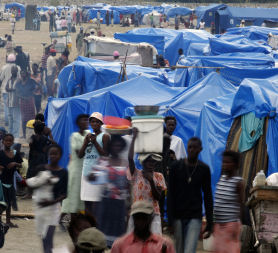The continuing struggle for Haiti's homeless
Updated on 24 May 2010
Millions were donated following Haiti's earthquake which killed over 200,000 people. But have basic necessities reached the vulnerable? Inigo Gilmore visits camps sheltering the homeless.

Four months on from the Haiti's devastating earthquake and there are persistent questions about just how much assistance and support the victims have received in the camps of Port-au-Prince, and what the future may hold for more than 1.2 million people displaced by the disaster.
Having been here now on the ground now for two months, it is fair to say that the aid effort presents a very mixed picture.
According to Oxfam there are at least 650 displacement camps in the city but even now no one knows for sure, with estimates putting the figure much higher. While some camps appear to be pretty well equipped - including the 'golf camp' in Petionville where Sean Penn's NGO is operating - others have clearly fallen through the cracks, and many are still without any proper shelter.
The delivery of sustained aid assistance is patchy at best. Aid officials say the scale of this disaster is so overwhelming that that they are still struggling to cope. It is difficult to establish a clear picture of who is getting aid or how far it is penetrating.
For my report I focussed on the story of Nadia Francois, a 37-year-old Haitian woman who previously lived in the United States before she was deported. She now runs two displacement camps in a mixed residential area of the city, Delmas 75.
Many of the more 3,500 camp residents were living in a ravine where their decrepit houses were damaged in the quake. Several families moved from the ravine to the hillside above, where a patchwork of pitiful shacks are now spread out, perched precariously on the edges of the ravine, badly exposed to potential landslides as the rainy seasons comes into full swing.
For three weeks I followed Nadia as she sought to get assistance for her camp. She is indefatigable, going out each day, to seek out UN officials, NGO coordinators from the major international agencies, and just about anyone who might help her camp.
Despite her best efforts she has struggled to get help.
Oxfam had been to her camp briefly but never returned. They put in latrines, showers and a water bladder for drinking water and other uses. The water bladder is now broken and the pit latrines are filled with excrement, which need to be cleared.
Nadia and I travelled over from her camp to golf camp in Petionville, where 50,000 are living on Haiti's only golf course. We went to meet with Julie Schindall, an Oxfam spokesperson. Oxfam has an impressive water project at golf camp, providing for the needs of the residents each day.
Nadia was burning with a sense of injustice, keen to drive her point home that her camp had not been revisited by the British charity, even though she had filled out paperwork for Oxfam. She wanted answers as to why they no longer seemed to be on Oxfam's radar, or that of other NGOs.
As so much else much else here, there are no easy answers.
Julie Schindall defended Oxfam's record, saying: "The magnitude of this disaster is beyond anything we have seen. There are over 650 camps, spontaneous settlement camps in this tight, dense urban area. It's very hard to reach some sites. We do not have the capacity.
"Oxfam cannot reach every single camp. What we can do is try to be in touch with the most vulnerable."
But many here feel that it is often the most vulnerable, the voiceless, who are still being left behind.
Police have started to evict tent dwellers, from some patches of private land, in some cases by force, without a media spotlight to highlight their plight.
I was with Nadia at one camp site on the edge of the city when bulldozers were at work, uprooting shelters of hundreds who had taken refugee there to make way for a formal, officially sanctioned camp site.
Many Haitians would prefer to be somewhere else than the places they have sought refuge but where are they supposed to go? It's a question that now hangs over Nadia's camp. The owner of the land where her camp is situated has warned that he may force residents to leave in the coming weeks, as he wants to build houses for sale.
"I will fight for my camp," says Nadia, with a glint in her eye. But taking on the authorities at a time when patience and sympathy are receding, it's a fight few would envy.




